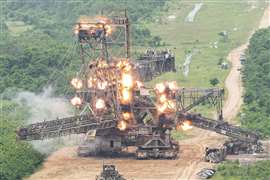Flashback: Four, 17-storey buildings imploded
June 25, 2024
In the 25 years since it was first published, D&Ri - like the demolition and recycling industry that it covers - has gone from strength to strength. Showcasing the vital and complex projects delivered by our industry friends and colleagues has always been at the heart of D&Ri, and it all started with this first site report.
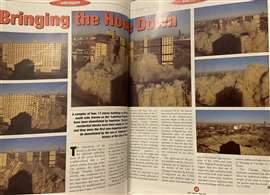 D&Ri’s first site report, published in 1999. (PHOTO: D&Ri/Brandenburg/CDI)
D&Ri’s first site report, published in 1999. (PHOTO: D&Ri/Brandenburg/CDI)
A complex of four, 17-storey buildings on Chicago’s south side, known as the “Lakefront Properties” have been demolished by implosion.
The high-rise residential blocks have been empty for 13 years and they were the first non-industrial buildings to be demolished by the use of implosion in the history of the City of Chicago.
The demolition of the blocks is the first step in the planned redevelopment of the north Kenwood neighbourhood into a new mixed income housing estate.
The project, for client the Chicago Housing Authority (CHA), was conducted on a fast-track basis and started in late September last year [1998].
After reviewing the qualifications of seven project teams, on October 27th, CHA awarded the US$2 million contractor for demolition by implosion to Chicago-based Brandenburg Industrial Service Company as the prime contractor.
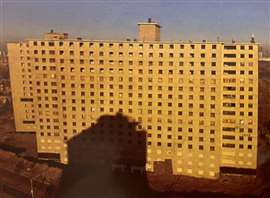 The four, 17-storey buildings on Chicago’s south side, known as the “Lakefront Properties”. (PHOTO: Brandenburg/CDI)
The four, 17-storey buildings on Chicago’s south side, known as the “Lakefront Properties”. (PHOTO: Brandenburg/CDI)
The explosives, demolition design, and performance operations then subcontracted to Controlled Demolition Incorporated (CDI) of Phoenix, in Maryland, USA.
Demolition methodology
Working on a phased basis, Brandenburg first removed asbestos and then the combustibles from each of the 17-storey structures.
As the materials were removed, CDI crews followed closely behind, drilling holes in the reinforced concrete columns for subsequent placement of explosives.
It took CDI’s loading crew 72 hours to place 830 lb (376 kg) of explosives in over 2,700 independently delayed locations throughout the four buildings.
The carefully timed explosive or “implosion sequence is designed to use the weight and structure of the buildings to break the framework of the blocks in mid-air, and direct the fall of debris away from the adjacent properties.
Early one morning in mid-December, crowds gathered to watch the impending implosion.
At precisely 08.30, the button was pressed and the south-east corner of the southern-most structure began to fall, as the implosion sequence proceeded through the complex from south to north, as planned.
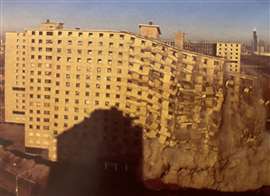 CDI’s loading crew placed 830 lb (376 kg) of explosives. (PHOTO: Brandenburg/CDI)
CDI’s loading crew placed 830 lb (376 kg) of explosives. (PHOTO: Brandenburg/CDI)
Clearing demolition debris
As the structures collapsed into four fragmented piles of debris, Brandenburg’s forces moved inside the implosion safety perimeter to clear the dust that had settled on streets and sidewalks.
The clean-up operation was completed in just three hours.
The significance of this project was that is was the first non-industrial use of implosion in the history of the City of Chicago.
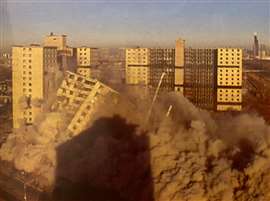 The clean-up operation was completed in just three hours. (PHOTO: Brandenburg/CDI)
The clean-up operation was completed in just three hours. (PHOTO: Brandenburg/CDI)
It was also the first use of implosion on the CHA’s vacant and obsolete high-rise blocks which were developed as part of the Federal high-rise program in the 1950s and early 1960s.
Reports from the project suggest that this first use implosion was enthusiastically received by both local authorities and community residents and there is every indication that the methodology will be used to remove additional high-rise public housing in Chicago in the future.
The Chicago Housing Authority estimated that demolition by implosion reduced the length of the time to complete the project and the overall costs by 15-20%.
Originally published in D&Ri, Volume 1, March-May 1999
MAGAZINE
NEWSLETTER
CONNECT WITH THE TEAM






